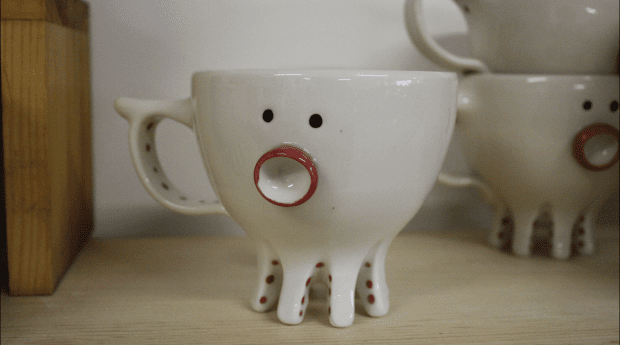
An adorable examples of Wai-Yant Li's work. Credit: Michelle Pucci
There’s nothing antique about Wai-Yant Li’s ceramic creations.
The mugs and bowls lining the shelves in Li’s Montreal studio can easily be mistaken for animated characters and animal sculptures and are now on display at the Salon des Métiers d’Art in Montreal.
“I know that people have rituals like coffee every morning, or cereal,” says Li, the ceramist behind Créations Li. “These objects become very precious to them.”
Li, who uses the gender-neutral pronouns “they” and “their,” is one of 800 artisans participating in the Salon des Métiers d’Art this month. The artist’s work was on display at this year’s One of a Kind show in Toronto and is now available at One of a Kind Online.
Born in Lac St-Jean, Quebec, Li’s pottery is a callback to early-childhood cartoons and animations combined with functionality. Most of the pieces have nothing more than a few dots of paint for a face, small legs and large colourful noses. Two of the more colourful creations are Chomps the Shark, a grey matte mug with a fin-shaped handle, and its dinosaur companion, Cup-o-Saurus, a tall white cup with spikes on its back and four tiny legs.
“Aesthetically, I like to keep things really simple,” Li says. “Does it need feet? Does it need eyes? Maybe it doesn’t need eyes; maybe all it needs is a beak.”
Créations Li already sells to three stores in Montreal, as well as stores in Ste-Agathe-des-Monts, St-Jean-sur-Richelieu and Pointe Claire. In the United States, Li’s work can be found at Earth and State in Philadelphia, New Discoveries in Chicago, and The Clay Pot and Uncommon Goods in Brooklyn.
Their success is a result of an effort made early on to bring the critters on the shelves to life by developing a clear and simple idea. With the help of two other potters, Créations Li is a team project and, as demand increases, will only continue to expand.
“Creatively, Wai-Yant is always trying to expand and create new things,” says Nathalie Antoine, who owns the Mile End boutique Poterie Manu Reva in Montreal. “Sometimes the new product is a bit weird, but it still sells very well.” It’s a success Li attributes to a strong vision in terms of style — despite working in a craft that is sometimes lacking in innovation, they say, referring to a generational divide in the industry.
“A lot of people were crafting in the ’70s, and the economy was really good. You could make a really good living doing crafting,” they say of the aging profession. “Eventually, things dropped and shifted.”
Something about the spirit of these simple ceramics speaks to all kinds of people, regardless of whether they are interested in ceramics, says Li’s studio mate Christian Roy. It’s easy to be taken by the different dopey grins on the Classic Companion mug or the confused-looking Stud the Spiky mug.
“It’s very inclusive; everyone is crazy about them, whether you’re a girl or a macho man,” Roy says.
Growing up queer miles away from the city, combined with having East Asian roots, Li admits times haven’t always been so easy. In an effort to make Montreal and Quebec more livable for other queer visible minorities, Li is also one of the organizers of Qouleur, a summer festival for people of colour that challenges hegemonic race and sexuality through workshops, performances and discussion.
“Unfortunately, systemic racism is still a very real thing,” they say. “The queer scene is still very white; it’s often very problematic towards people of colour, so we’re there to challenge the status quo of what it means to be queer.”
One way of doing this is by offering the Créations Li studio as a space to hold meetings and social events like potlucks and film screenings. “I have my own space — this is how it’s going to be: pottery and a lot of activism, so whoever walks in better be okay with that,” Li says.
They are also part of Empty Bowls, a charity event in which ceramists donate a bowl in support of local food banks. Participants eat soup out of the handcrafted bowls and keep them for a $20 donation.
Although the activist would like to offer more to projects like Qouleur or new undertakings, “real life gets in the way.”
“I also have this dream of this house for my parents because they’re not financially stable,” they say. “I need to support them, so unfortunately, I do have to work to make enough money to not only support me, but support my family as well.”
To achieve this goal, Li applies a work ethic acquired over the years balancing multiple part-time jobs and studies. The studio is a very productive place, to say the least. It’s been home to numerous collaborations, including a few with queer Spanish artist and activist Coco Guzman (aka Coco Riot). Li recently worked with the Toronto-based artist on a ceramics series featuring extinct animals.
“We wanted to commemorate these animals in these art pieces,” Li said, explaining that the proceeds go to wildlife foundations.
Laughing, Li describes the unfortunate demise of the pig-footed bandicoot illustrated on one of the cracked plates hanging in the studio. Two of the last three bandicoots became the prey of a lost famished scientist who was hoping to do research on them.
“And that’s how they got extinct.”
creations.li

 Why you can trust Xtra
Why you can trust Xtra


